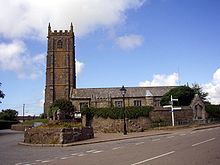The church of St Buryan
| St. Buryan's Church, St. Buryan | |
|---|---|

St. Buryan's Church
|
|
| Denomination | Church of England |
| Churchmanship | Broad Church |
| History | |
| Dedication | St. Buryan |
| Administration | |
| Parish | St Buryan |
| Diocese | Truro |
| Province | Canterbury |
Coordinates: 50°04′31″N 05°37′22″W / 50.07528°N 5.62278°W
The Church of St Buryan is a late-15th-century Church of England parish church in St Buryan in Cornwall, England.
A church has stood on the current site since c.930. King Athelstan stopped to pray at Saint Buriana's chapel, of which little now remains, during his conquest of Cornwall before his campaign against the Scilly Isles. He vowed to erect a college of clergy where the oratory stood if God blessed his expedition with success. Upon his triumphant return, having subdued Scilly, Athelstan endowed a church in honour of Saint Buriana with a charter that established St Buryan as one of the earliest monasteries in Cornwall. The church structure was later enlarged and dedicated to the saint in 1238 by Bishop William Brewer However, by 1473 the church had fallen into disrepair, with large sections having to be subsequently rebuilt. The current tower, completed in 1501, is 92 feet (28 m) high and constructed of wrought-cut granite from nearby Lamorna. Many years later the same granite was used to build Old London Bridge. The tower is divided into four stages, and has double buttresses at each angle. An octagonal turret rises at the south-east corner and contains a spiral staircase. The bulk of the present church building was added in the late 15th and 16th century and the north wall re-built in the 18th century, at the same time as the demolition of a small lean-to chapel on the north wall of the chancel. In 1814, the church was restored yet again when the benches and screen were replaced and on 7 August 1875 the church was re-opened by, Frederick Temple, the Bishop of Exeter following another restoration. He also consecrated the new churchyard. In 1956 the present Lady Chapel was erected as a gift of John Franklin Tonkin, in memory of his uncle, Robert Edmund Tonkin, of Treverven. The church is currently classified as a Grade I listed building.
...
Wikipedia
